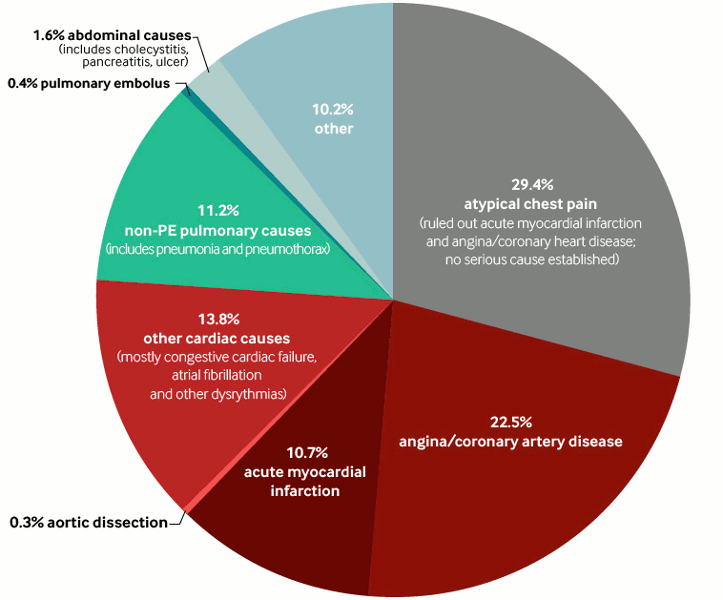A retrospective study in the US, conducted over a 5-year period, of patients aged over 35 years, with a chief complaint of non-traumatic chest pain admitted to hospital from the emergency department, found that chest pain most frequently had a coronary cause.[7]Kohn MA, Kwan E, Gupta M, et al. Prevalence of acute myocardial infarction and other serious diagnoses in patients presenting to an urban emergency department with chest pain. J Emerg Med. 2005 Nov;29(4):383-90.
http://www.ncbi.nlm.nih.gov/pubmed/16243193?tool=bestpractice.com
Pulmonary embolism and aortic dissection were rare but important causes.[7]Kohn MA, Kwan E, Gupta M, et al. Prevalence of acute myocardial infarction and other serious diagnoses in patients presenting to an urban emergency department with chest pain. J Emerg Med. 2005 Nov;29(4):383-90.
http://www.ncbi.nlm.nih.gov/pubmed/16243193?tool=bestpractice.com
[Figure caption and citation for the preceding image starts]: Distribution of final diagnoses in people over 35 years admitted to hospital from one US hospital emergency department with chief complaint of non-traumatic chest pain, over a 5-year period (PE, pulmonary embolism)Created by BMJ; based on data from Kohn MA, Kwan E, Gupta M, et al. Prevalence of acute myocardial infarction and other serious diagnoses in patients presenting to an urban emergency department with chest pain. J Emerg Med. 2005 Nov;29(4):383-90 [Citation ends].
Data from accident and emergency departments in Northern Europe indicate that approximately 10% to 12% of patients presenting with chest pain will receive a diagnosis of unstable angina or myocardial infarction.[8]Lindskou TA, Andersen PJ, Christensen EF, et al. More emergency patients presenting with chest pain. PLoS One. 2023 Mar 23;18(3):e0283454.
https://journals.plos.org/plosone/article?id=10.1371/journal.pone.0283454
http://www.ncbi.nlm.nih.gov/pubmed/36952460?tool=bestpractice.com
[9]Bjørnsen LP, Naess-Pleym LE, Dale J, et al. Description of chest pain patients in a Norwegian emergency department. Scand Cardiovasc J. 2019 Feb;53(1):28-34.
https://www.tandfonline.com/doi/full/10.1080/14017431.2019.1583362
http://www.ncbi.nlm.nih.gov/pubmed/30760035?tool=bestpractice.com
Reports have indicated that up to 3.5% of patients with a diagnosis of acute coronary syndrome have the diagnosis missed in the emergency department.[10]Pope JH, Aufderheide TP, Ruthazer R, et al. Missed diagnoses of acute cardiac ischemia in the emergency department. N Engl J Med. 2000 Apr 20;342(16):1163-70.
http://www.nejm.org/doi/full/10.1056/NEJM200004203421603#t=article
http://www.ncbi.nlm.nih.gov/pubmed/10770981?tool=bestpractice.com
[11]Collinson PO, Premachandram S, Hashemi K. Prospective audit of incidence of prognostically important myocardial damage in patients discharged from emergency department. BMJ. 2000 Jun 24;320(7251):1702-5.
http://www.bmj.com/content/320/7251/1702.long
http://www.ncbi.nlm.nih.gov/pubmed/10864545?tool=bestpractice.com
[12]Aldous SJ, Richards M, Cullen L, et al. A 2-hour thrombolysis in myocardial infarction score outperforms other risk stratification tools in patients presenting with possible acute coronary syndromes: comparison of chest pain risk stratification tools. Am Heart J. 2012 Oct;164(4):516-23.
http://www.ncbi.nlm.nih.gov/pubmed/23067909?tool=bestpractice.com
The distribution of aetiologies is different in primary care. Common aetiologies of chest pain in this setting include:[13]Bader AS, Rubinowitz AN, Gange CP Jr, et al. Imaging in the evaluation of chest pain in the primary care setting, part 2: sources of noncardiac chest pain. Am J Med. 2020 Oct;133(10):1135-42.
https://www.amjmed.com/article/S0002-9343(20)30416-2/fulltext
http://www.ncbi.nlm.nih.gov/pubmed/32442508?tool=bestpractice.com
[14]Haasenritter J, Biroga T, Keunecke C, et al. Causes of chest pain in primary care--a systematic review and meta-analysis. Croat Med J. 2015 Oct;56(5):422-30.
https://www.ncbi.nlm.nih.gov/pmc/articles/PMC4655927
http://www.ncbi.nlm.nih.gov/pubmed/26526879?tool=bestpractice.com
Musculoskeletal causes
Reflux oesophagitis
Costochondritis.
An observational study found that most final diagnoses in people presenting with chest pain in primary care are non-life-threatening; however, 8.4% have a life-threatening final diagnosis.[6]Hoorweg BB, Willemsen RT, Cleef LE, et al. Frequency of chest pain in primary care, diagnostic tests performed and final diagnoses. Heart. 2017 Nov;103(21):1727-32.
http://www.ncbi.nlm.nih.gov/pubmed/28634285?tool=bestpractice.com
Another study in general practice settings found that most patients had no diagnosis assigned at presentation (72.4%) or within the next 6 months following a first episode of chest pain (no previous record of cardiovascular disease).[15]Jordan KP, Timmis A, Croft P, et al. Prognosis of undiagnosed chest pain: linked electronic health record cohort study. BMJ. 2017 Apr 3;357:j1194.
http://www.bmj.com/content/357/bmj.j1194.long
http://www.ncbi.nlm.nih.gov/pubmed/28373173?tool=bestpractice.com
Those patients who had no diagnosis attributed to their chest pain at 6 months had higher long-term incidence of cardiovascular events compared with patients who had been diagnosed with non-coronary pain.
